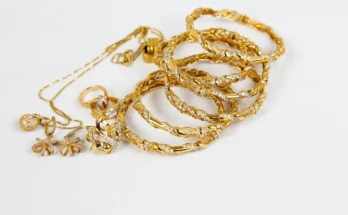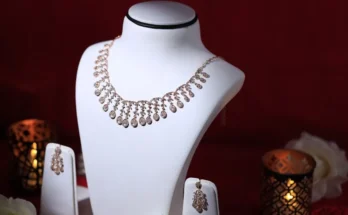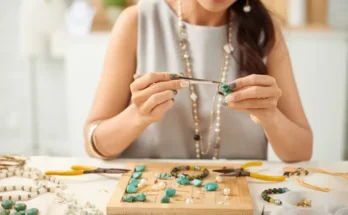Jewellery is not merely about sparkle—it’s a whisper from the past, a celebration of the present, and a vision of the future. Across every civilization, social class, and century, humans have adorned themselves with glittering objects for reasons far deeper than vanity.
Whether it’s a diamond engagement ring symbolizing eternal love or a handcrafted pendant passed down through generations, jewellery carries emotion, memory, and meaning in every detail. It’s one of the few art forms we wear against our skin—intimate, expressive, and deeply personal.
A Journey Through History:
Long before modern fashion or Instagram-worthy trends, early humans crafted jewellery from bones, shells, and stones. These were not simply ornaments—they were protective talismans, tribal markers, and expressions of status or spirituality. In ancient Egypt, jewellery was believed to connect the wearer with the gods. Amulets shaped like scarabs or ankhs were symbols of protection and rebirth. Pharaohs were buried with their jewels, believing the precious metals would accompany them to the afterlife.
Similarly, in Mesopotamia, India, and China, jewellery was a sign of power, divinity, and cultural sophistication. Gold wasn’t just a metal; it was a message.
Throughout the Middle Ages and into the Renaissance, jewellery continued to evolve into a status symbol. European monarchs wore elaborate crowns and gemstone-encrusted regalia to broadcast their divine right to rule. In many cultures, jewellery also played an integral role in marriage and courtship rituals—gifting a piece of jewellery became a declaration of intention, wealth, and emotional commitment. By the 19th century, romanticism transformed jewellery into an art form. With the rise of sentimental jewellery, lockets, mourning rings, and pieces engraved with secret messages became wildly popular. Jewels were no longer just seen—they were felt.
The Language of Jewellery:
Every piece of jewellery tells a story. A pearl necklace might evoke memories of a grandmother’s elegance, while a charm bracelet carries snapshots of life’s most cherished moments. Jewellery can mark a milestone, commemorate a love, or remind the wearer of strength through hardship. Different gemstones and materials also carry symbolic meanings. Emeralds often represent rebirth, sapphires denote wisdom, and rubies are linked to passion. Even the settings—such as a halo or solitaire—have design languages that reflect intention and emotion.
Jewellery also communicates heritage. In India, for example, intricate gold bangles and nose rings play crucial roles in bridal ceremonies, often passed down through generations. In West Africa, beads are worn to reflect social status, family lineage, and spiritual beliefs. Native American turquoise jewellery blends natural elements with cultural storytelling. Each tradition tells its tale through material, motif, and technique. Jewellery becomes not just an accessory, but a living thread connecting ancestors to descendants.
Redefining Jewellery in the 21st Century:
-
From Fine Jewellery to Fashion Statements
Today, jewellery straddles both tradition and trend. Fine jewellers still create timeless heirlooms, while fashion-forward designers push the envelope with bold, innovative designs. People wear jewellery not just for special occasions, but as part of their daily identity—layered necklaces, stacked rings, mismatched earrings. There are no rules, only style.
Brands have adapted, too. Customization is on the rise. Consumers want pieces that reflect their names, stories, and journeys. From personalized nameplate necklaces to birthstone rings tailored to a child’s birth month, jewellery is more personal than ever.
-
The Influence of Pop Culture and Social Media
Celebrities and influencers have turned jewellery into cultural currency. When Rihanna debuts a bold choker or Harry Styles dons a string of pearls, trends shift overnight. Instagram, TikTok, and Pinterest are now the new runways for jewellery, where a single viral video can make a style iconic.
But in the age of fast fashion, jewellery still holds the power to slow us down—to savor something handcrafted, thoughtful, and lasting.
The New Luxury Standard:
-
Rethinking Materials and Sourcing
As consumers become more conscious of where their products come from, the jewellery industry is responding. Ethical sourcing, conflict-free diamonds, and recycled metals are becoming non-negotiables for many buyers. Transparency in the supply chain matters as much as the sparkle.
Lab-grown diamonds, once dismissed, are now embraced as environmentally responsible and scientifically stunning. They offer the same brilliance as mined gems but with a lighter ecological footprint.
-
Supporting Artisans and Local Craft
There’s a growing appreciation for handmade jewellery crafted by skilled artisans. These pieces often tell richer stories and support cultural preservation. In many parts of the world, local jewellery-making is not just a tradition but a lifeline, providing income, education, and community strength.
Ethical jewellery is more than a label—it’s a commitment to beauty with integrity.
Jewellery as Self-Expression and Empowerment:
Jewellery has become a tool for personal expression. It says who we are—or who we want to be. A bold cuff can channel power, a dainty ring can whisper grace. We wear jewellery for job interviews, first dates, protests, and parties. It reflects our mood, status, rebellion, or joy.
And in a world where identities are fluid, jewellery helps affirm them. LGBTQ+ individuals often wear specific symbols—rainbow gems, triangle pendants—to celebrate pride and visibility. Religious pendants or spiritual charms remind wearers of deeper beliefs and purpose.
Perhaps no jewellery is more meaningful than that which is inherited. Heirloom pieces carry memory, love, and legacy. A mother’s wedding ring, a grandfather’s watch, a vintage brooch—they link us to our roots. Wearing them is not just a style choice; it’s a sacred connection across time.
These pieces whisper, “You’re part of something bigger.”
Conclusion:
Jewellery may be small in size, but it holds a universe of meaning. From its ancient origins to its modern reinventions, it remains one of the most powerful ways we express who we are, what we love, and what we remember.
It sparkles, yes—but its true brilliance lies in its symbolism, its history, and its ability to endure when words fail. Whether passed down, gifted, bought on a whim, or chosen with deep intention, jewellery always tells a story. And that story is always worth wearing.




